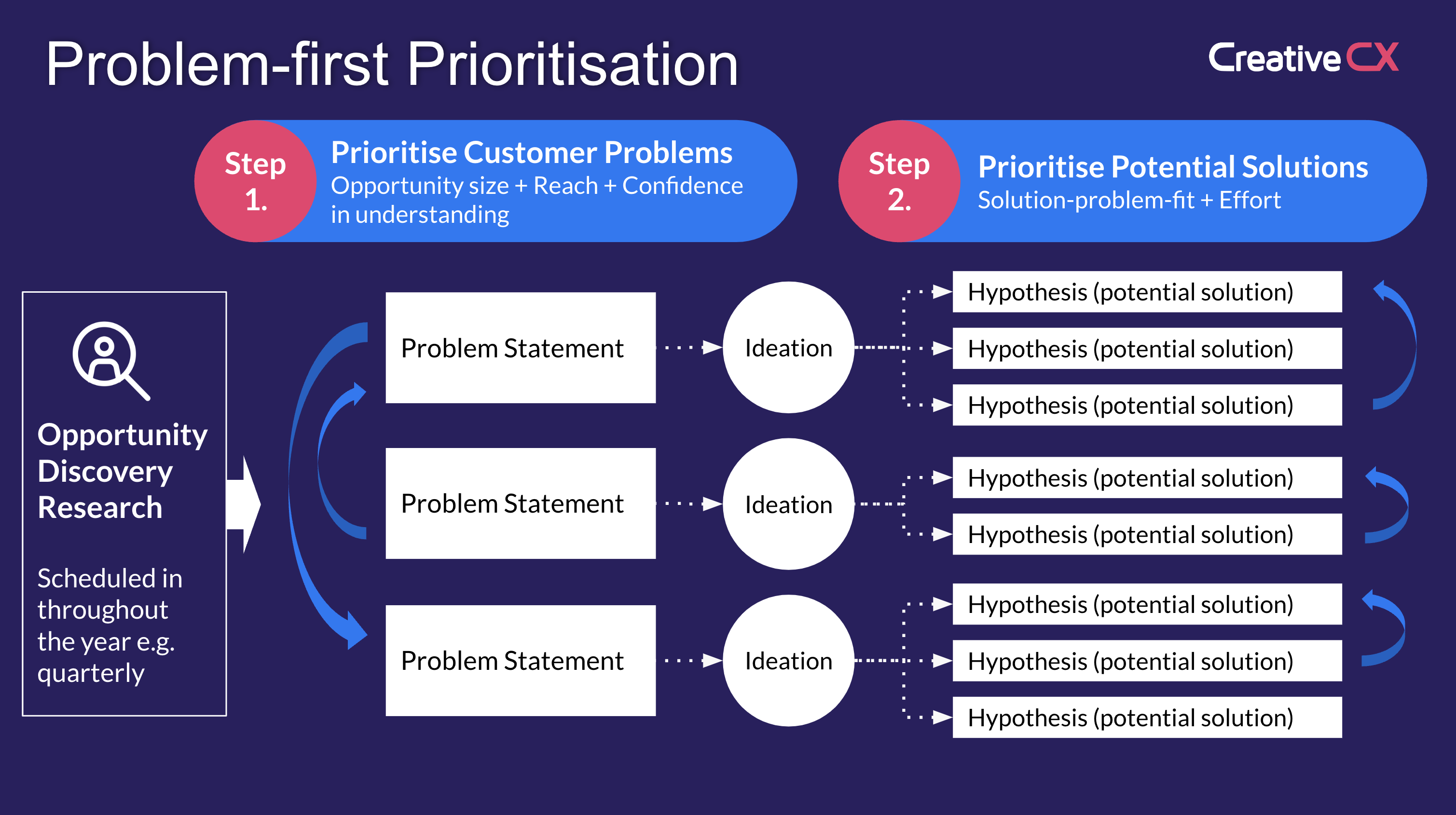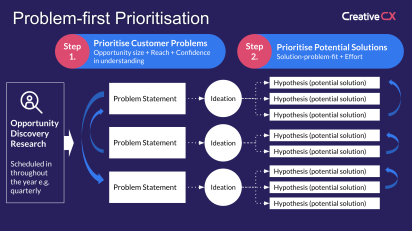Does your team jump straight into brainstorming solutions without first having an in-depth understanding of the customer’s problem?
Do they focus all of their resources on complicated shiny features or redesigns that are trying to solve non-existent problems?
Creative CX recognised that this approach, while common, can lead to wasted effort and poor results. This observation brought about the idea of prioritising problems before even thinking about solutions.
This problem-first approach ensures that every solution is connected to real customer issues, identified through rigorous research. It’s a transformative way of working that has already proven its value by delivering better outcomes for CCX’s clients.
The Challenges of Existing Approaches
Many organisations operate with a solution-first mentality, where ideas are prioritised, and research is used to justify those ideas afterwards. Creative CX has observed that this approach encourages bias, a particular confirmation bias (we’ve labelled as FILTH), with teams focusing on data that supports their ideas rather than allowing genuine customer needs to guide them. While this might feel productive, it often leads to teams solving the wrong problems or creating solutions to problems that don’t exist.
Organisations often focus on optimising individual features, backed by extensive data. But what they miss is the larger opportunity: solving the underlying customer frustrations that spanned the entire user journey.
The result? A lot of effort is spent on micro-optimisations, with limited overall impact.
CCX recognised that this approach is preventing teams from unlocking bigger wins. By reversing the order (prioritising problems first) they’ve found teams work on what truly matters, solving the underlying causes of customer problems.
Creative CX’s Problem-First Approach
What does it mean to prioritise problems first?
It starts with opportunity discover research, a deep dive into customer behaviour, pain points, and unmet needs. This isn’t about brainstorming solutions early on; it’s about understanding what’s truly affecting customers by gathering data from various sources like usability tests, customer interviews, and behavioural analytics.
Once the data is collected, the next step is to form customer problem statements. These statements are developed by combining insights from the research to ensure that the problems identified are backed by solid evidence from multiple sources. By focusing on these carefully researched problem statements, the team ensures that they’re tackling the right issues from the start.
But identifying problems isn’t enough – they also need to be quantified. This means asking, “How many customers are affected by this issue?” and “What impact does solving this problem have on the overall experience?”. This is where the customer problem statements are ranked based on factors like the number customers affected, the severity of the issue, and alignment with business goals.
After defining and quantifying the customer problem statements, the next step is to prioritise them based on their impact on both customers and the business. During quarterly planning sessions, teams and leadership review the problem statement and decide which ones to address in the upcoming quarter. This ensures that the most significant opportunities are tackled first, making efforts more focused and impactful.
The team then moves onto ideation. As the groundwork has already been laid, these sessions are highly focused and aligned with real customer needs, preventing the common mistake of jumping into solutions too early without understanding those needs.
Finally, the teams engage in experimentation and iteration. They test the proposed solutions, refine them, and continue experimenting to solve the problems that are most important to customers. This approach ensures that solutions are not only relevant but also deliver meaningful results for both the customer and the business.
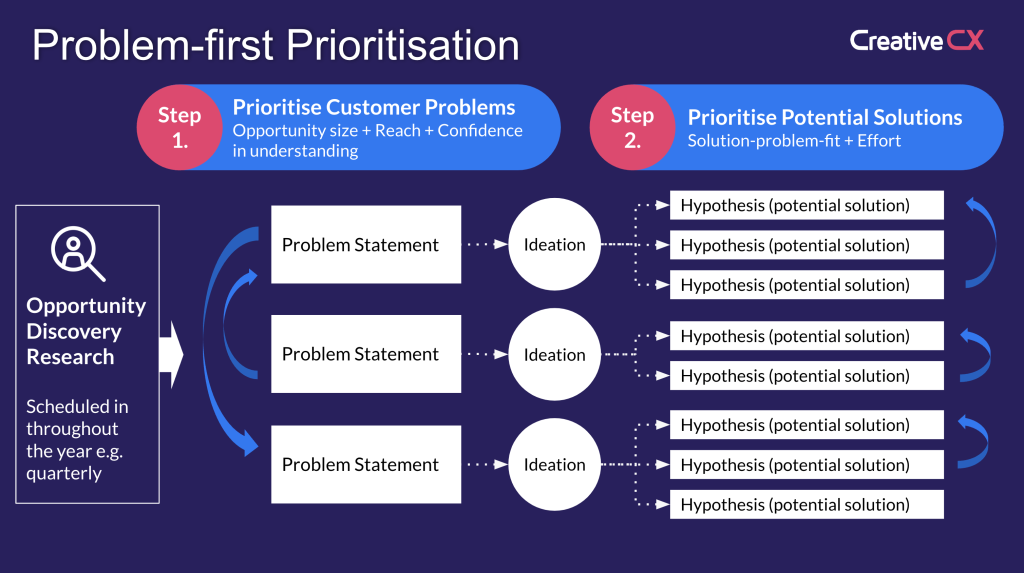
Opportunity Discovery Research
The secret sauce of CCX’s approach is the opportunity discovery research, the team identifies important customer problems by conducting end-to-end research across the customer journey and pulling insights from a range of sources
This means they combine qualitative insights from usability tests and customer interviews with quantitative data to get a full picture of where the friction points are.
This approach ensures that they’re not just reacting to one-off issues but are identifying the underlying problems that affect the customer journey as a whole. By gathering data from multiple sources, they build a clearer understanding of the real issues impacting the customer experience.
For an example, during an audit of a flight booking journey, usability testing revealed confusion over a specific modal, which caused hesitation and uncertainty among users. While the qualitative data highlighted the confusion, the full extent of the problem became clear only when quantitative analysis confirmed that this step was a significant friction point, affecting overall conversion rates. The quantitative analysis also comes into the prioritisation stage by helping the team to quantify the scale of the issue. By combining these insights, the team was able to pinpoint the issue and then devise a solution.
This holistic approach, blending both qualitative and quantitative data, helps uncover hidden problems that might not be visible through one lens alone. It provides a solid foundation for the entire problem-first prioritisation process, ensuring that the team is focused on solving the issues that deliver the most value to both the customer and the business.
Collaboration and Leadership Alignment
Throughout this process, collaboration plays a crucial role.
The research phase is led by UX researchers and data analysts, who present their findings to the wider team. These team members have a crucial role in uncovering customer problems and opportunities but too often are left on the sidelines. Problem-first prioritisation ensures that everyone is working from the same, evidence-based understanding of the problems before moving onto solutions.
Another key to the problem-first approach is how it integrates leadership. Once the customer problem statements are defined, leadership steps in to help decide which problems should take priority, ensuring alignment with the company’s broader goals.
However, it’s up to teams to decide how to solve these problems. Through doing it this way, the problem-first approach involves senior leadership at the right stages.
This balance between leadership direction and team autonomy ensures that senior leaders provide strategic focus early on, allowing teams the space to ideate and implement solutions effectively. Through contributing at the prioritisation stage, leadership gains confidence that their teams are executing a strategy designed to succeed at meeting both customer needs and business goals.
This approach bridges the gap between day-to-day optimisation and long-term strategy. Leadership provides the high-level focus, while the teams are empowered to use their expertise to experiment and deliver solutions that tackle the most significant problems.
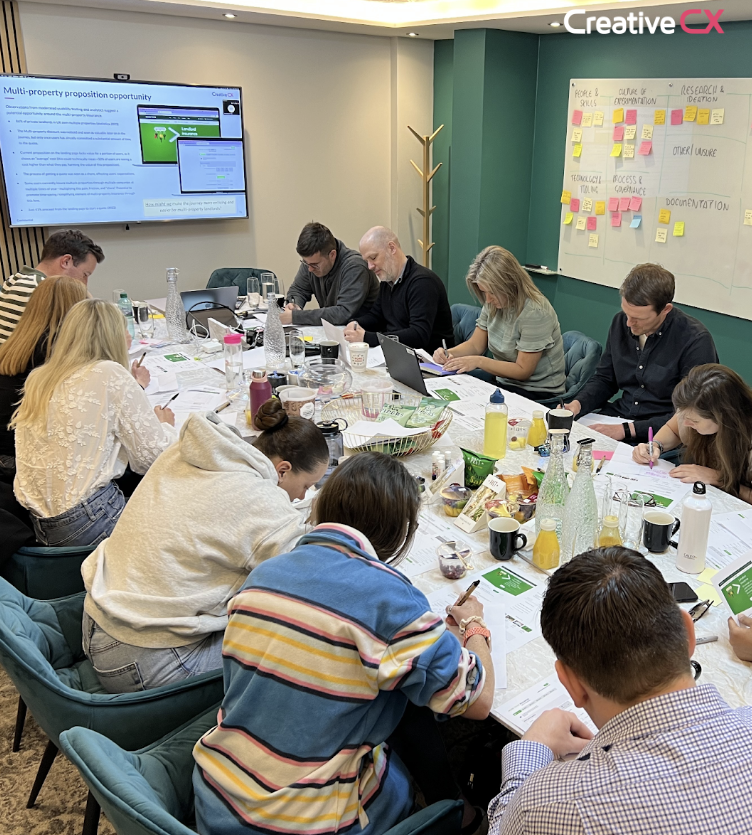
How Can I Start Problem-First Prioritisation?
One of the strengths of CCX’s approach is that it’s designed to be flexible.
Every business has its own way of working, and this method can adapt to fit into existing processes. Whether your team manages priorities on a simple spreadsheet or uses a more sophisticated system like Jira, the problem-first approach can be implemented with whatever tools you’re already using.
To get started, you’ll want to follow these core steps:
- Schedule in your regular opportunity discovery research: First, decide which end-to-end journey to focus on, this will help you avoid focusing on pages rather than journeys. Then you can start gathering insights from multiple sources – this could be customer interviews, usability testing, or behavioural data from your analytics platform. The key is to pull together information from various angles so you’re getting a full picture of what your customers are struggling with.
- Develop clear customer problem statements: Once you’ve got your research, the next step is to turn those insights into actionable problem statements. These statements should outline the biggest issues your customers are facing, backed by real evidence. It’s important to keep these statements specific and focused to guide your team toward solving the most impactful problems. You can read more about problem statements here.
- Prioritise problems based on customer impact: Once the customer problem statements are created, they need to be prioritised. This involves ranking the problems based on how many customers are affected and how much solving each issue would improve the overall experience. These problems are then presented to leadership in quarterly meetings to ensure strategic alignment.
- Fit the process into your existing workflow: How you manage the next steps depends on your existing setup. If you’re using a simple spreadsheet, you can list the problems, prioritise them, and track the progress of ideation and testing. If your team uses a system like Jira, you can integrate the problem-first approach into ticketing and prioritisation system. Fitting this into your workflow goes beyond just technical implementation, for product-led organisations you would want to align discovery, prioritisation and ideation to quarterly planning. The method is adaptable, allowing you to integrate it with the tools and processes that you currently use.
- Empower your team to ideate and implement: After prioritisation, your team can begin ideation, brainstorming solutions specifically targeted at the prioritised problems. These ideation sessions should lead to strong, testable hypotheses. In product organisations, this responsibility would often fall to the product team for the specific area in question. By assigning the task to the relevant product team, you ensure that the people closest to the area of focus are driving the experimentation and implementation efforts. Give them the freedom to experiment with different approaches, and make sure that solutions are tested and implemented with customer impact in mind.
- Maintain flexibility and revisit regularly: Problem-first prioritisation isn’t static. As customer needs evolve, so should your problem statements and priorities. Make it a regular practice to revisit and expand upon your research and ensure your team is always focused on the most pressing customer problems.
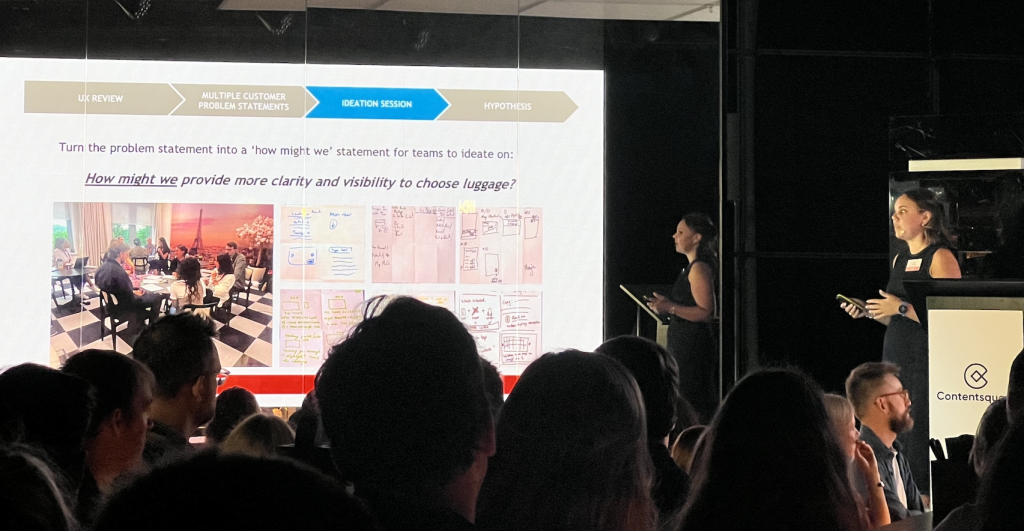
Impact on Results: Customer and Business Outcomes
One client of CCX’s has already started implementing the problem-first prioritisation method. Vicky Routley, CRO Manager at EasyJet, recently spoke at a ContentSquare event about their experience of implementing the process, and you can watch the video here.
Since implementing problem-first they are now triangulating qualitative and quantitative data from the quarterly UX reviews to create their problem statements before ideating.
One example Vicky mentioned involved a problem where users struggled with logging in after using the ‘forgotten details’ option. This insight came from a combination of user research and data, which showed a sharp drop in conversion rates for users who went back to the homepage compared to those who didn’t. The resulting test, grounded in solving this customer problem, led to a 6% increase in log-in success and +3% conversion rate following a forgotten password click.
One thing Vicky touched on in her talk was how their process now brings a wider range of teams into their ideation sessions, for example customer service or proposition teams. As Vicky put it, “If you bring different people into the room, you’ll get different opinions and views and, therefore, better ideas.”
Vicky’s talk showed how a shift toward problem-first prioritisation can deliver real, measurable results as well as better collaboration between teams.
Conclusion
CCX’s problem-first prioritisation approach doesn’t just change how teams work, it reshapes how they approach challenges. By focusing on customer problems before ideating solutions, they achieve results that truly matter to them and their customers.
Win rates improve because teams are working on real, evidence-backed problems rather than ideas that may not truly resonate with customers. Customers are happier because their pain points are addressed.
At CCX, we know that problem-first prioritisation can have a transformational effect on how teams work together, making them more effective at solving the problems that matter most and leading to improved user experiences. We believe that instead of pouring energy into optimisation or redesigns, companies should first address the painful user journeys their customers face.
If your team finds itself buried in ideas or struggling with low win rates, take a step back and ask: are we solving the right problems?
Our team can guide you through the entire process, from opportunity discovery research to prioritising customer problems and delivering solutions. Whether you’re working with simple tools or more complex systems, we can tailor our approach to fit your workflow. If you’re ready to start solving the right problems and transform the way your team works, get in touch with us today.
